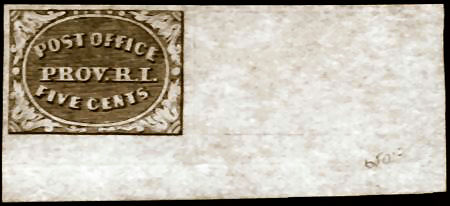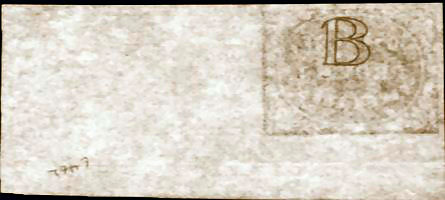![]()
Postal History Introduction
Stampless
Covers
1846
to 1900 Issues
1901-1950
Issues
1951-2003
Issues
Cancels
&
Miscellaneous
Postal
Stationery
Post
Cards
Air
Mail
First
Day &
Event Covers
Parcel Post/Special Delivery
Registered & Official Mail
Commercial & Advertising
Revenue & Postage Due
Wildlife & Game Issues
Complete List of RI Issues
Rhode Island Stamp
Issues - Providence Postmaster's Provisional
1898 Reprint of the 1846 Providence
Postmaster's Provisional
Bottom right sheet corner margin - Position 12 - Scott #10x1R
|
|
|
The 1898 reprints of 10X1 and 10X2 were made from the same plates as the original stamps. They were printed on two types of paper; a Rhode Island variety and a New York variety. The stamps were engraved on a copper plate containing 12 stamps. Each plate contained eleven 5c stamps and one 10c stamp in the upper right hand corner. They were engraved directly on the plate, thus each stamp position differs slightly from the others. There is no period after CENTS on the 10 cent issue and positions 4, 5, 6, 9, 11 and 12 of the 5c issue. The original 1846 issues are worth more used than in mint condition. The reprints were not issued for postal usage. Most of the reprints have a letter on the back; either B, O, G, E, R, T, D, U, R, I, or N. Some of the reprints did not receive the letters on the reverse. The stamp above has the letter B as shown on the reverse scan. There were several facsimile (fake) prints of these stamps, the most famous being the Geneva facsimiles. The printing on the facsimiles is generally courser and they were sold with cancellations strategically covering the obvious defects. The Facsimile stamp issues also tended to have heavy borders on all four sides. The originals and the 1898 reprints have heavy borders only on the right and bottom edges as can be seen from the example above. |
![]()
RI Historical
Society
The Post Offices
Home Page
RI Tercentenary Issue History
RI Philatelic Society
Recently Added Pages
Philatelic Primer
Rhode Island Around the World
Rhode Island
Town Postmarks
Other Websites of Interest
Return to 1846-1900 Issues Thumbnail Page Part 1

